Organisational Behaviour Report: Culture, Motivation and Sainsbury's
VerifiedAdded on 2022/12/02
|10
|2979
|160
Report
AI Summary
This report provides an in-depth analysis of organisational behaviour, focusing on Sainsbury's as a case study. It begins with an introduction to organisational behaviour, its key elements, and its importance in understanding workplace dynamics. The report then explores various theories of organisational culture, including Handy's typology and Hofstede's cultural dimensions, evaluating their relevance to Sainsbury's. It examines the impact of culture on employee motivation, emphasizing the role of communication models like linear and transactional communication. Furthermore, the report discusses Maslow's hierarchy of needs in the context of Sainsbury's, analysing how the company can meet employee needs to foster a motivated workforce. The report concludes with an evaluation of ways Sainsbury's can utilize business culture to gain success.
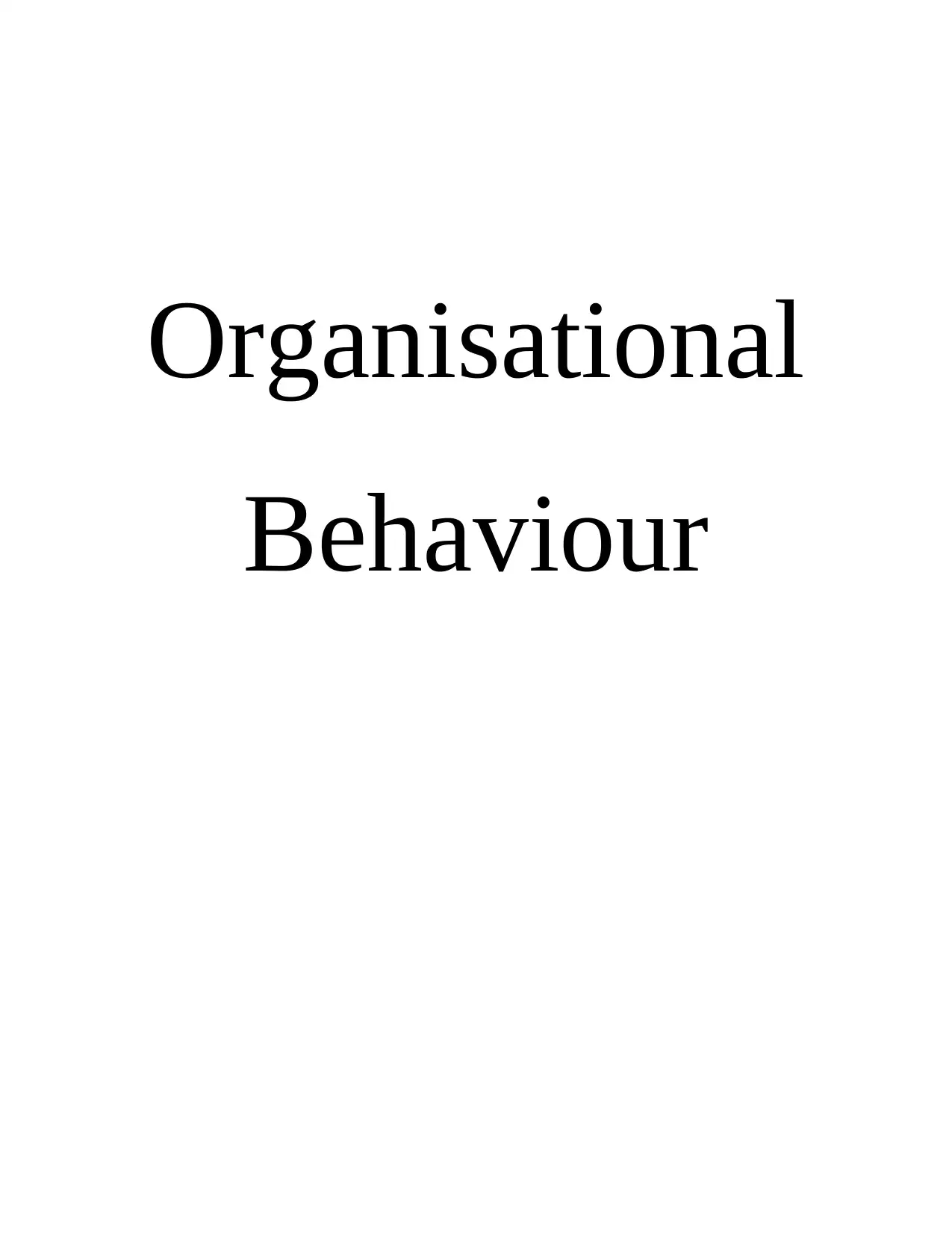
Organisational
Behaviour
Behaviour
Paraphrase This Document
Need a fresh take? Get an instant paraphrase of this document with our AI Paraphraser
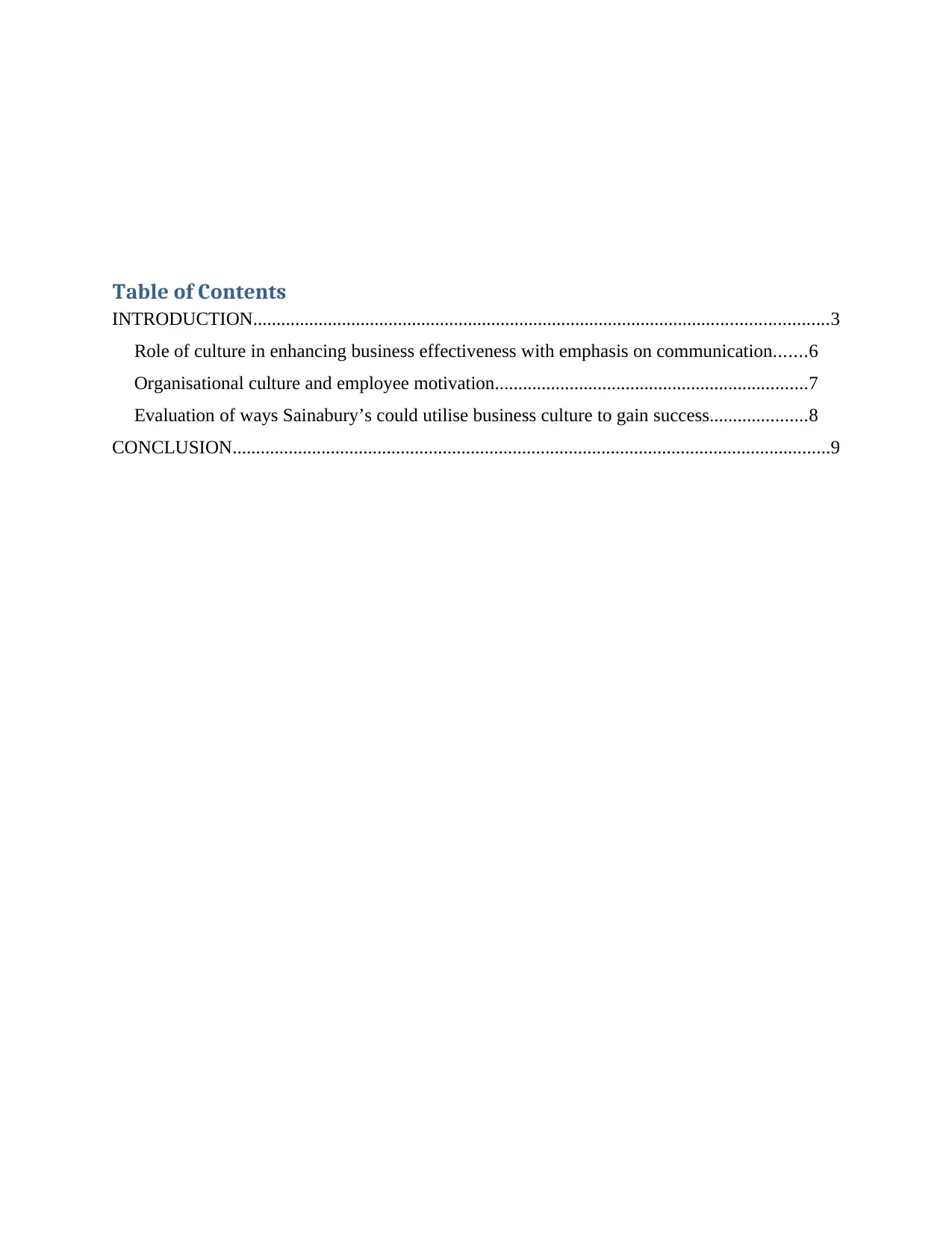
Table of Contents
INTRODUCTION...........................................................................................................................3
Role of culture in enhancing business effectiveness with emphasis on communication.......6
Organisational culture and employee motivation...................................................................7
Evaluation of ways Sainabury’s could utilise business culture to gain success.....................8
CONCLUSION................................................................................................................................9
INTRODUCTION...........................................................................................................................3
Role of culture in enhancing business effectiveness with emphasis on communication.......6
Organisational culture and employee motivation...................................................................7
Evaluation of ways Sainabury’s could utilise business culture to gain success.....................8
CONCLUSION................................................................................................................................9
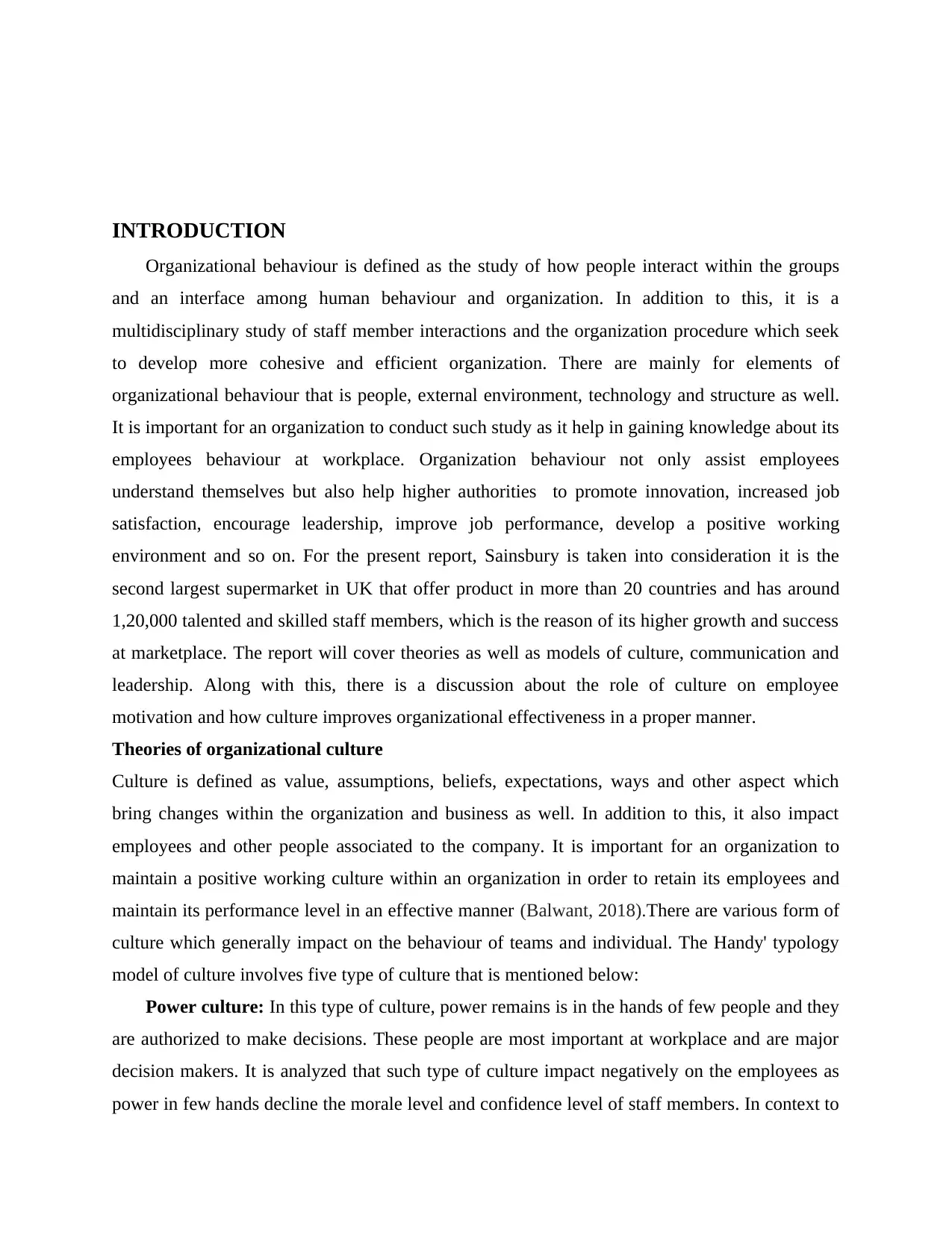
INTRODUCTION
Organizational behaviour is defined as the study of how people interact within the groups
and an interface among human behaviour and organization. In addition to this, it is a
multidisciplinary study of staff member interactions and the organization procedure which seek
to develop more cohesive and efficient organization. There are mainly for elements of
organizational behaviour that is people, external environment, technology and structure as well.
It is important for an organization to conduct such study as it help in gaining knowledge about its
employees behaviour at workplace. Organization behaviour not only assist employees
understand themselves but also help higher authorities to promote innovation, increased job
satisfaction, encourage leadership, improve job performance, develop a positive working
environment and so on. For the present report, Sainsbury is taken into consideration it is the
second largest supermarket in UK that offer product in more than 20 countries and has around
1,20,000 talented and skilled staff members, which is the reason of its higher growth and success
at marketplace. The report will cover theories as well as models of culture, communication and
leadership. Along with this, there is a discussion about the role of culture on employee
motivation and how culture improves organizational effectiveness in a proper manner.
Theories of organizational culture
Culture is defined as value, assumptions, beliefs, expectations, ways and other aspect which
bring changes within the organization and business as well. In addition to this, it also impact
employees and other people associated to the company. It is important for an organization to
maintain a positive working culture within an organization in order to retain its employees and
maintain its performance level in an effective manner (Balwant, 2018).There are various form of
culture which generally impact on the behaviour of teams and individual. The Handy' typology
model of culture involves five type of culture that is mentioned below:
Power culture: In this type of culture, power remains is in the hands of few people and they
are authorized to make decisions. These people are most important at workplace and are major
decision makers. It is analyzed that such type of culture impact negatively on the employees as
power in few hands decline the morale level and confidence level of staff members. In context to
Organizational behaviour is defined as the study of how people interact within the groups
and an interface among human behaviour and organization. In addition to this, it is a
multidisciplinary study of staff member interactions and the organization procedure which seek
to develop more cohesive and efficient organization. There are mainly for elements of
organizational behaviour that is people, external environment, technology and structure as well.
It is important for an organization to conduct such study as it help in gaining knowledge about its
employees behaviour at workplace. Organization behaviour not only assist employees
understand themselves but also help higher authorities to promote innovation, increased job
satisfaction, encourage leadership, improve job performance, develop a positive working
environment and so on. For the present report, Sainsbury is taken into consideration it is the
second largest supermarket in UK that offer product in more than 20 countries and has around
1,20,000 talented and skilled staff members, which is the reason of its higher growth and success
at marketplace. The report will cover theories as well as models of culture, communication and
leadership. Along with this, there is a discussion about the role of culture on employee
motivation and how culture improves organizational effectiveness in a proper manner.
Theories of organizational culture
Culture is defined as value, assumptions, beliefs, expectations, ways and other aspect which
bring changes within the organization and business as well. In addition to this, it also impact
employees and other people associated to the company. It is important for an organization to
maintain a positive working culture within an organization in order to retain its employees and
maintain its performance level in an effective manner (Balwant, 2018).There are various form of
culture which generally impact on the behaviour of teams and individual. The Handy' typology
model of culture involves five type of culture that is mentioned below:
Power culture: In this type of culture, power remains is in the hands of few people and they
are authorized to make decisions. These people are most important at workplace and are major
decision makers. It is analyzed that such type of culture impact negatively on the employees as
power in few hands decline the morale level and confidence level of staff members. In context to
⊘ This is a preview!⊘
Do you want full access?
Subscribe today to unlock all pages.

Trusted by 1+ million students worldwide
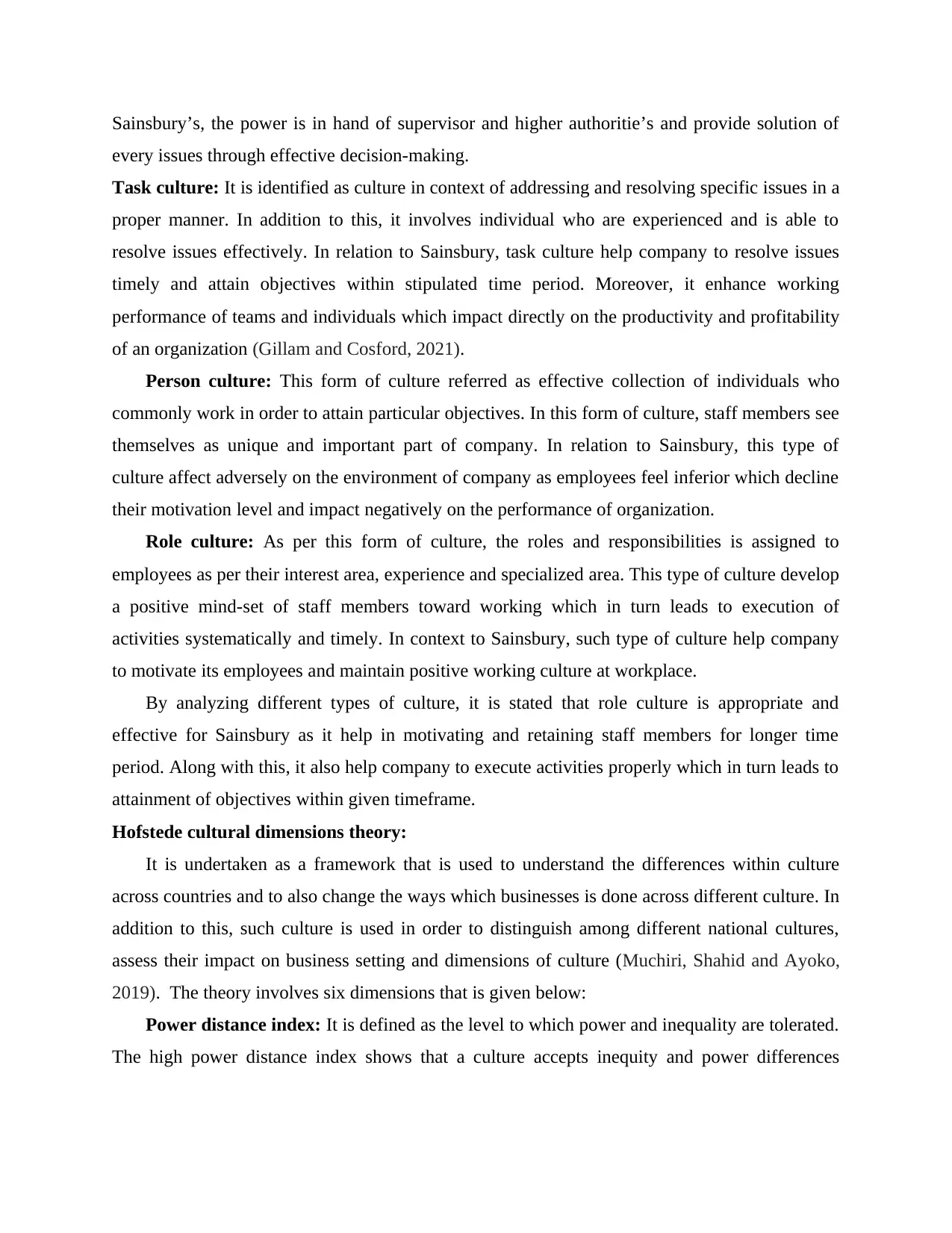
Sainsbury’s, the power is in hand of supervisor and higher authoritie’s and provide solution of
every issues through effective decision-making.
Task culture: It is identified as culture in context of addressing and resolving specific issues in a
proper manner. In addition to this, it involves individual who are experienced and is able to
resolve issues effectively. In relation to Sainsbury, task culture help company to resolve issues
timely and attain objectives within stipulated time period. Moreover, it enhance working
performance of teams and individuals which impact directly on the productivity and profitability
of an organization (Gillam and Cosford, 2021).
Person culture: This form of culture referred as effective collection of individuals who
commonly work in order to attain particular objectives. In this form of culture, staff members see
themselves as unique and important part of company. In relation to Sainsbury, this type of
culture affect adversely on the environment of company as employees feel inferior which decline
their motivation level and impact negatively on the performance of organization.
Role culture: As per this form of culture, the roles and responsibilities is assigned to
employees as per their interest area, experience and specialized area. This type of culture develop
a positive mind-set of staff members toward working which in turn leads to execution of
activities systematically and timely. In context to Sainsbury, such type of culture help company
to motivate its employees and maintain positive working culture at workplace.
By analyzing different types of culture, it is stated that role culture is appropriate and
effective for Sainsbury as it help in motivating and retaining staff members for longer time
period. Along with this, it also help company to execute activities properly which in turn leads to
attainment of objectives within given timeframe.
Hofstede cultural dimensions theory:
It is undertaken as a framework that is used to understand the differences within culture
across countries and to also change the ways which businesses is done across different culture. In
addition to this, such culture is used in order to distinguish among different national cultures,
assess their impact on business setting and dimensions of culture (Muchiri, Shahid and Ayoko,
2019). The theory involves six dimensions that is given below:
Power distance index: It is defined as the level to which power and inequality are tolerated.
The high power distance index shows that a culture accepts inequity and power differences
every issues through effective decision-making.
Task culture: It is identified as culture in context of addressing and resolving specific issues in a
proper manner. In addition to this, it involves individual who are experienced and is able to
resolve issues effectively. In relation to Sainsbury, task culture help company to resolve issues
timely and attain objectives within stipulated time period. Moreover, it enhance working
performance of teams and individuals which impact directly on the productivity and profitability
of an organization (Gillam and Cosford, 2021).
Person culture: This form of culture referred as effective collection of individuals who
commonly work in order to attain particular objectives. In this form of culture, staff members see
themselves as unique and important part of company. In relation to Sainsbury, this type of
culture affect adversely on the environment of company as employees feel inferior which decline
their motivation level and impact negatively on the performance of organization.
Role culture: As per this form of culture, the roles and responsibilities is assigned to
employees as per their interest area, experience and specialized area. This type of culture develop
a positive mind-set of staff members toward working which in turn leads to execution of
activities systematically and timely. In context to Sainsbury, such type of culture help company
to motivate its employees and maintain positive working culture at workplace.
By analyzing different types of culture, it is stated that role culture is appropriate and
effective for Sainsbury as it help in motivating and retaining staff members for longer time
period. Along with this, it also help company to execute activities properly which in turn leads to
attainment of objectives within given timeframe.
Hofstede cultural dimensions theory:
It is undertaken as a framework that is used to understand the differences within culture
across countries and to also change the ways which businesses is done across different culture. In
addition to this, such culture is used in order to distinguish among different national cultures,
assess their impact on business setting and dimensions of culture (Muchiri, Shahid and Ayoko,
2019). The theory involves six dimensions that is given below:
Power distance index: It is defined as the level to which power and inequality are tolerated.
The high power distance index shows that a culture accepts inequity and power differences
Paraphrase This Document
Need a fresh take? Get an instant paraphrase of this document with our AI Paraphraser
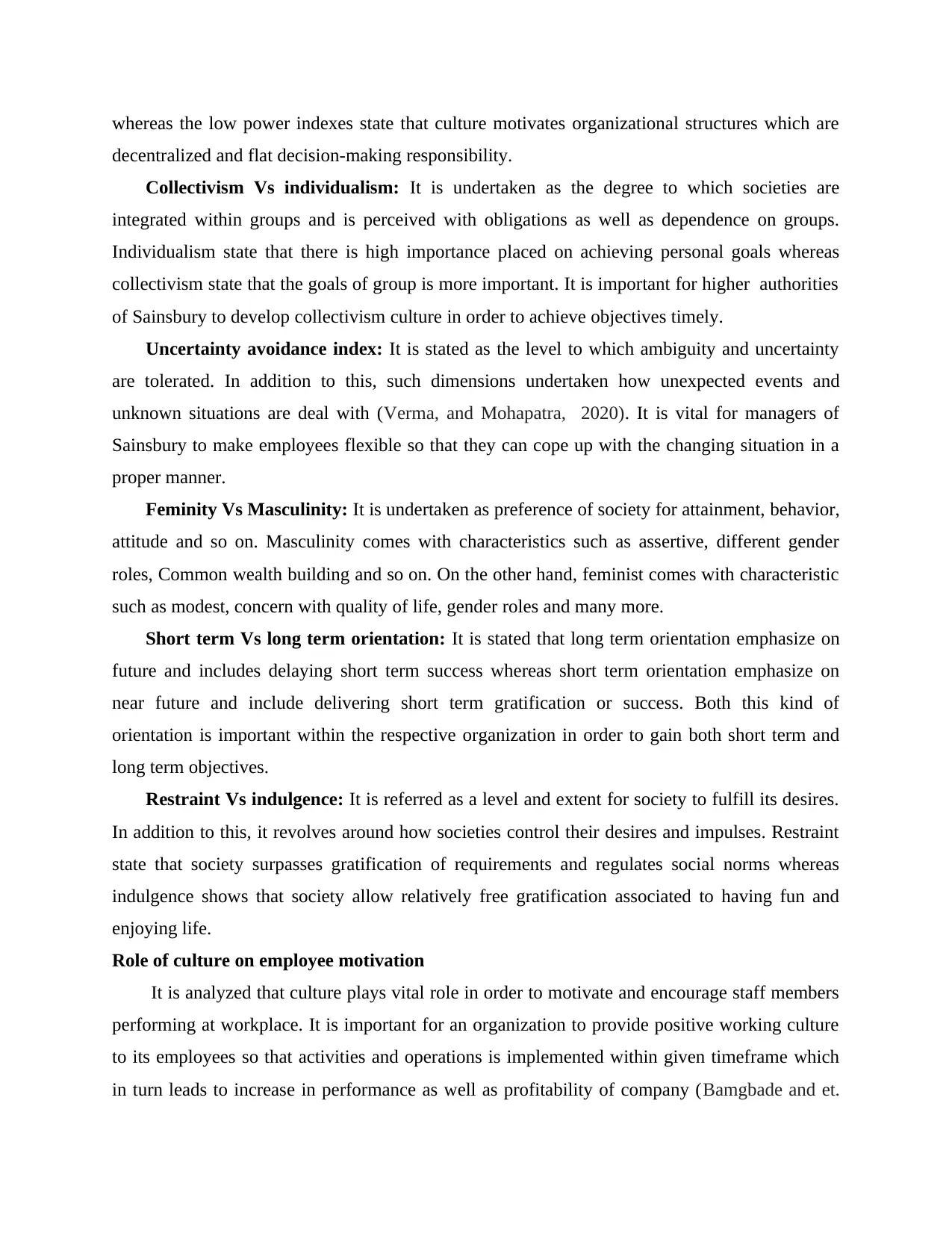
whereas the low power indexes state that culture motivates organizational structures which are
decentralized and flat decision-making responsibility.
Collectivism Vs individualism: It is undertaken as the degree to which societies are
integrated within groups and is perceived with obligations as well as dependence on groups.
Individualism state that there is high importance placed on achieving personal goals whereas
collectivism state that the goals of group is more important. It is important for higher authorities
of Sainsbury to develop collectivism culture in order to achieve objectives timely.
Uncertainty avoidance index: It is stated as the level to which ambiguity and uncertainty
are tolerated. In addition to this, such dimensions undertaken how unexpected events and
unknown situations are deal with (Verma, and Mohapatra, 2020). It is vital for managers of
Sainsbury to make employees flexible so that they can cope up with the changing situation in a
proper manner.
Feminity Vs Masculinity: It is undertaken as preference of society for attainment, behavior,
attitude and so on. Masculinity comes with characteristics such as assertive, different gender
roles, Common wealth building and so on. On the other hand, feminist comes with characteristic
such as modest, concern with quality of life, gender roles and many more.
Short term Vs long term orientation: It is stated that long term orientation emphasize on
future and includes delaying short term success whereas short term orientation emphasize on
near future and include delivering short term gratification or success. Both this kind of
orientation is important within the respective organization in order to gain both short term and
long term objectives.
Restraint Vs indulgence: It is referred as a level and extent for society to fulfill its desires.
In addition to this, it revolves around how societies control their desires and impulses. Restraint
state that society surpasses gratification of requirements and regulates social norms whereas
indulgence shows that society allow relatively free gratification associated to having fun and
enjoying life.
Role of culture on employee motivation
It is analyzed that culture plays vital role in order to motivate and encourage staff members
performing at workplace. It is important for an organization to provide positive working culture
to its employees so that activities and operations is implemented within given timeframe which
in turn leads to increase in performance as well as profitability of company (Bamgbade and et.
decentralized and flat decision-making responsibility.
Collectivism Vs individualism: It is undertaken as the degree to which societies are
integrated within groups and is perceived with obligations as well as dependence on groups.
Individualism state that there is high importance placed on achieving personal goals whereas
collectivism state that the goals of group is more important. It is important for higher authorities
of Sainsbury to develop collectivism culture in order to achieve objectives timely.
Uncertainty avoidance index: It is stated as the level to which ambiguity and uncertainty
are tolerated. In addition to this, such dimensions undertaken how unexpected events and
unknown situations are deal with (Verma, and Mohapatra, 2020). It is vital for managers of
Sainsbury to make employees flexible so that they can cope up with the changing situation in a
proper manner.
Feminity Vs Masculinity: It is undertaken as preference of society for attainment, behavior,
attitude and so on. Masculinity comes with characteristics such as assertive, different gender
roles, Common wealth building and so on. On the other hand, feminist comes with characteristic
such as modest, concern with quality of life, gender roles and many more.
Short term Vs long term orientation: It is stated that long term orientation emphasize on
future and includes delaying short term success whereas short term orientation emphasize on
near future and include delivering short term gratification or success. Both this kind of
orientation is important within the respective organization in order to gain both short term and
long term objectives.
Restraint Vs indulgence: It is referred as a level and extent for society to fulfill its desires.
In addition to this, it revolves around how societies control their desires and impulses. Restraint
state that society surpasses gratification of requirements and regulates social norms whereas
indulgence shows that society allow relatively free gratification associated to having fun and
enjoying life.
Role of culture on employee motivation
It is analyzed that culture plays vital role in order to motivate and encourage staff members
performing at workplace. It is important for an organization to provide positive working culture
to its employees so that activities and operations is implemented within given timeframe which
in turn leads to increase in performance as well as profitability of company (Bamgbade and et.
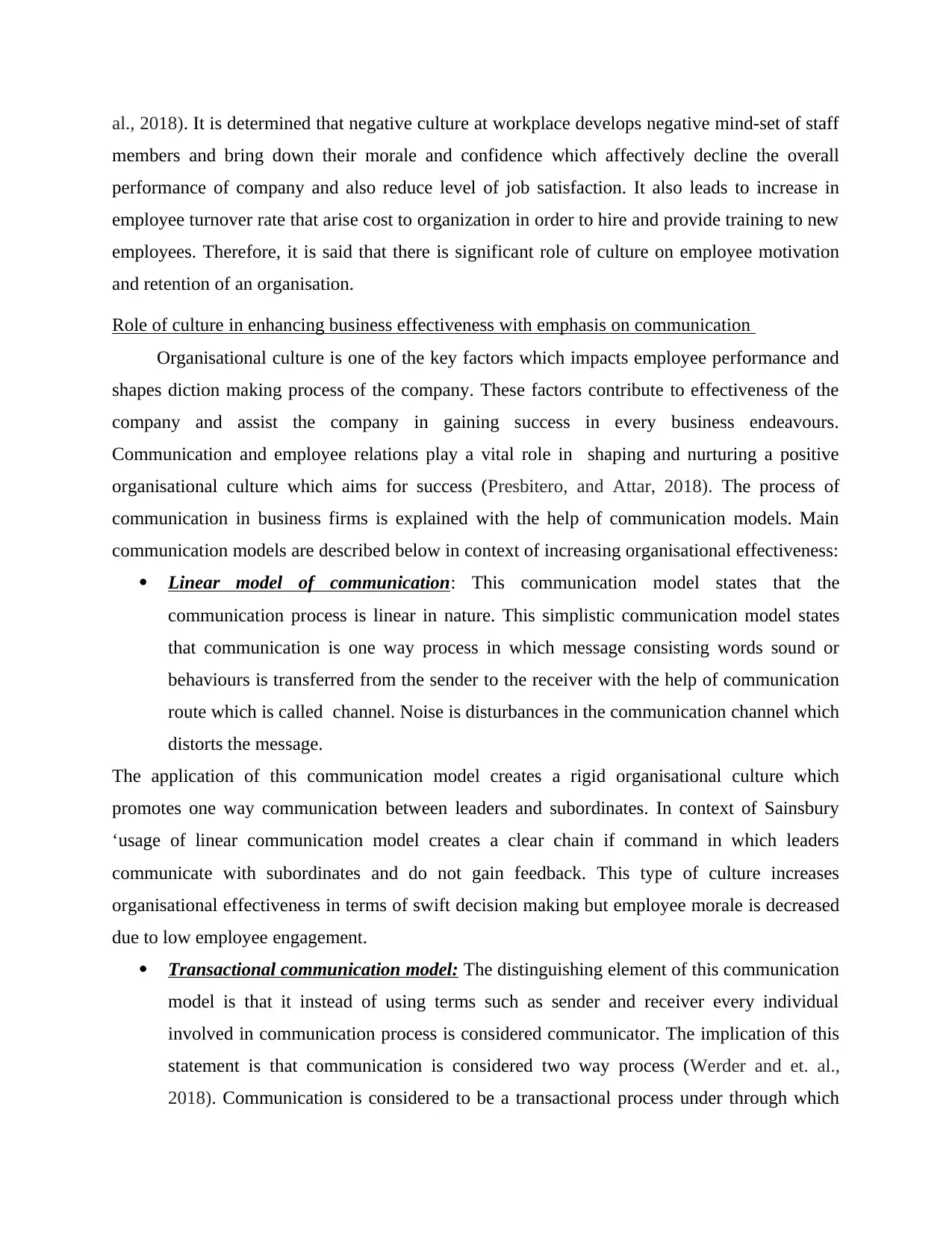
al., 2018). It is determined that negative culture at workplace develops negative mind-set of staff
members and bring down their morale and confidence which affectively decline the overall
performance of company and also reduce level of job satisfaction. It also leads to increase in
employee turnover rate that arise cost to organization in order to hire and provide training to new
employees. Therefore, it is said that there is significant role of culture on employee motivation
and retention of an organisation.
Role of culture in enhancing business effectiveness with emphasis on communication
Organisational culture is one of the key factors which impacts employee performance and
shapes diction making process of the company. These factors contribute to effectiveness of the
company and assist the company in gaining success in every business endeavours.
Communication and employee relations play a vital role in shaping and nurturing a positive
organisational culture which aims for success (Presbitero, and Attar, 2018). The process of
communication in business firms is explained with the help of communication models. Main
communication models are described below in context of increasing organisational effectiveness:
Linear model of communication: This communication model states that the
communication process is linear in nature. This simplistic communication model states
that communication is one way process in which message consisting words sound or
behaviours is transferred from the sender to the receiver with the help of communication
route which is called channel. Noise is disturbances in the communication channel which
distorts the message.
The application of this communication model creates a rigid organisational culture which
promotes one way communication between leaders and subordinates. In context of Sainsbury
‘usage of linear communication model creates a clear chain if command in which leaders
communicate with subordinates and do not gain feedback. This type of culture increases
organisational effectiveness in terms of swift decision making but employee morale is decreased
due to low employee engagement.
Transactional communication model: The distinguishing element of this communication
model is that it instead of using terms such as sender and receiver every individual
involved in communication process is considered communicator. The implication of this
statement is that communication is considered two way process (Werder and et. al.,
2018). Communication is considered to be a transactional process under through which
members and bring down their morale and confidence which affectively decline the overall
performance of company and also reduce level of job satisfaction. It also leads to increase in
employee turnover rate that arise cost to organization in order to hire and provide training to new
employees. Therefore, it is said that there is significant role of culture on employee motivation
and retention of an organisation.
Role of culture in enhancing business effectiveness with emphasis on communication
Organisational culture is one of the key factors which impacts employee performance and
shapes diction making process of the company. These factors contribute to effectiveness of the
company and assist the company in gaining success in every business endeavours.
Communication and employee relations play a vital role in shaping and nurturing a positive
organisational culture which aims for success (Presbitero, and Attar, 2018). The process of
communication in business firms is explained with the help of communication models. Main
communication models are described below in context of increasing organisational effectiveness:
Linear model of communication: This communication model states that the
communication process is linear in nature. This simplistic communication model states
that communication is one way process in which message consisting words sound or
behaviours is transferred from the sender to the receiver with the help of communication
route which is called channel. Noise is disturbances in the communication channel which
distorts the message.
The application of this communication model creates a rigid organisational culture which
promotes one way communication between leaders and subordinates. In context of Sainsbury
‘usage of linear communication model creates a clear chain if command in which leaders
communicate with subordinates and do not gain feedback. This type of culture increases
organisational effectiveness in terms of swift decision making but employee morale is decreased
due to low employee engagement.
Transactional communication model: The distinguishing element of this communication
model is that it instead of using terms such as sender and receiver every individual
involved in communication process is considered communicator. The implication of this
statement is that communication is considered two way process (Werder and et. al.,
2018). Communication is considered to be a transactional process under through which
⊘ This is a preview!⊘
Do you want full access?
Subscribe today to unlock all pages.

Trusted by 1+ million students worldwide
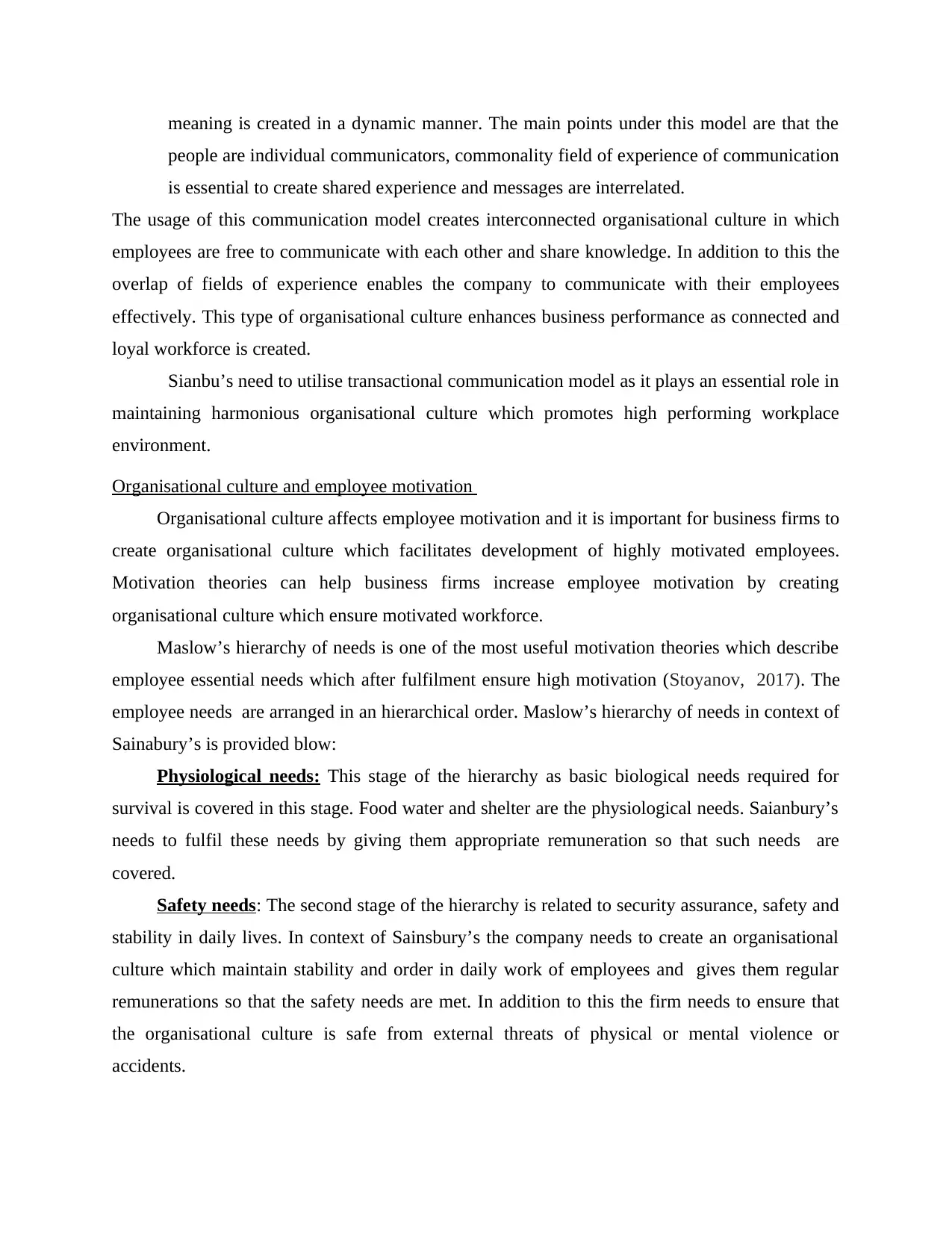
meaning is created in a dynamic manner. The main points under this model are that the
people are individual communicators, commonality field of experience of communication
is essential to create shared experience and messages are interrelated.
The usage of this communication model creates interconnected organisational culture in which
employees are free to communicate with each other and share knowledge. In addition to this the
overlap of fields of experience enables the company to communicate with their employees
effectively. This type of organisational culture enhances business performance as connected and
loyal workforce is created.
Sianbu’s need to utilise transactional communication model as it plays an essential role in
maintaining harmonious organisational culture which promotes high performing workplace
environment.
Organisational culture and employee motivation
Organisational culture affects employee motivation and it is important for business firms to
create organisational culture which facilitates development of highly motivated employees.
Motivation theories can help business firms increase employee motivation by creating
organisational culture which ensure motivated workforce.
Maslow’s hierarchy of needs is one of the most useful motivation theories which describe
employee essential needs which after fulfilment ensure high motivation (Stoyanov, 2017). The
employee needs are arranged in an hierarchical order. Maslow’s hierarchy of needs in context of
Sainabury’s is provided blow:
Physiological needs: This stage of the hierarchy as basic biological needs required for
survival is covered in this stage. Food water and shelter are the physiological needs. Saianbury’s
needs to fulfil these needs by giving them appropriate remuneration so that such needs are
covered.
Safety needs: The second stage of the hierarchy is related to security assurance, safety and
stability in daily lives. In context of Sainsbury’s the company needs to create an organisational
culture which maintain stability and order in daily work of employees and gives them regular
remunerations so that the safety needs are met. In addition to this the firm needs to ensure that
the organisational culture is safe from external threats of physical or mental violence or
accidents.
people are individual communicators, commonality field of experience of communication
is essential to create shared experience and messages are interrelated.
The usage of this communication model creates interconnected organisational culture in which
employees are free to communicate with each other and share knowledge. In addition to this the
overlap of fields of experience enables the company to communicate with their employees
effectively. This type of organisational culture enhances business performance as connected and
loyal workforce is created.
Sianbu’s need to utilise transactional communication model as it plays an essential role in
maintaining harmonious organisational culture which promotes high performing workplace
environment.
Organisational culture and employee motivation
Organisational culture affects employee motivation and it is important for business firms to
create organisational culture which facilitates development of highly motivated employees.
Motivation theories can help business firms increase employee motivation by creating
organisational culture which ensure motivated workforce.
Maslow’s hierarchy of needs is one of the most useful motivation theories which describe
employee essential needs which after fulfilment ensure high motivation (Stoyanov, 2017). The
employee needs are arranged in an hierarchical order. Maslow’s hierarchy of needs in context of
Sainabury’s is provided blow:
Physiological needs: This stage of the hierarchy as basic biological needs required for
survival is covered in this stage. Food water and shelter are the physiological needs. Saianbury’s
needs to fulfil these needs by giving them appropriate remuneration so that such needs are
covered.
Safety needs: The second stage of the hierarchy is related to security assurance, safety and
stability in daily lives. In context of Sainsbury’s the company needs to create an organisational
culture which maintain stability and order in daily work of employees and gives them regular
remunerations so that the safety needs are met. In addition to this the firm needs to ensure that
the organisational culture is safe from external threats of physical or mental violence or
accidents.
Paraphrase This Document
Need a fresh take? Get an instant paraphrase of this document with our AI Paraphraser
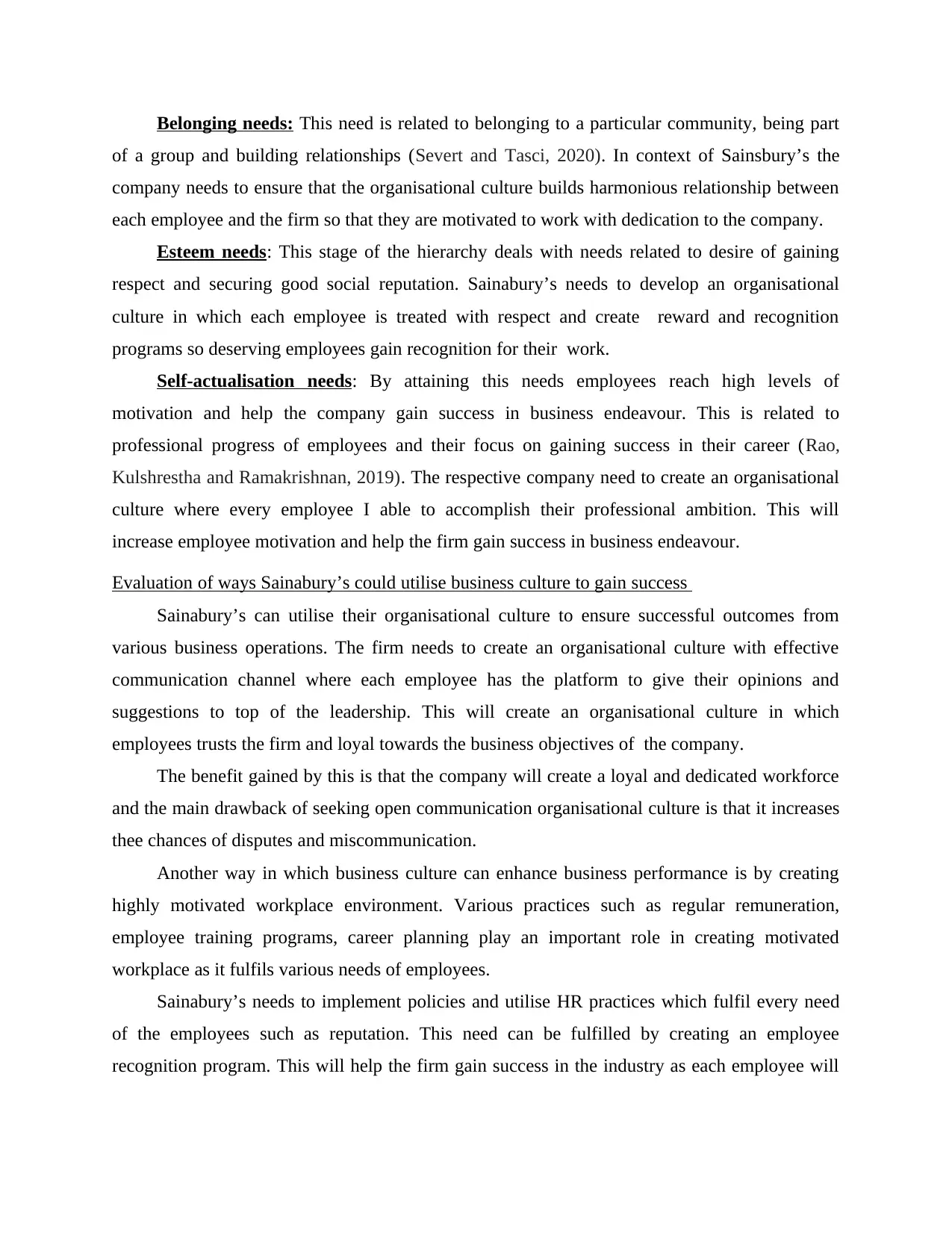
Belonging needs: This need is related to belonging to a particular community, being part
of a group and building relationships (Severt and Tasci, 2020). In context of Sainsbury’s the
company needs to ensure that the organisational culture builds harmonious relationship between
each employee and the firm so that they are motivated to work with dedication to the company.
Esteem needs: This stage of the hierarchy deals with needs related to desire of gaining
respect and securing good social reputation. Sainabury’s needs to develop an organisational
culture in which each employee is treated with respect and create reward and recognition
programs so deserving employees gain recognition for their work.
Self-actualisation needs: By attaining this needs employees reach high levels of
motivation and help the company gain success in business endeavour. This is related to
professional progress of employees and their focus on gaining success in their career (Rao,
Kulshrestha and Ramakrishnan, 2019). The respective company need to create an organisational
culture where every employee I able to accomplish their professional ambition. This will
increase employee motivation and help the firm gain success in business endeavour.
Evaluation of ways Sainabury’s could utilise business culture to gain success
Sainabury’s can utilise their organisational culture to ensure successful outcomes from
various business operations. The firm needs to create an organisational culture with effective
communication channel where each employee has the platform to give their opinions and
suggestions to top of the leadership. This will create an organisational culture in which
employees trusts the firm and loyal towards the business objectives of the company.
The benefit gained by this is that the company will create a loyal and dedicated workforce
and the main drawback of seeking open communication organisational culture is that it increases
thee chances of disputes and miscommunication.
Another way in which business culture can enhance business performance is by creating
highly motivated workplace environment. Various practices such as regular remuneration,
employee training programs, career planning play an important role in creating motivated
workplace as it fulfils various needs of employees.
Sainabury’s needs to implement policies and utilise HR practices which fulfil every need
of the employees such as reputation. This need can be fulfilled by creating an employee
recognition program. This will help the firm gain success in the industry as each employee will
of a group and building relationships (Severt and Tasci, 2020). In context of Sainsbury’s the
company needs to ensure that the organisational culture builds harmonious relationship between
each employee and the firm so that they are motivated to work with dedication to the company.
Esteem needs: This stage of the hierarchy deals with needs related to desire of gaining
respect and securing good social reputation. Sainabury’s needs to develop an organisational
culture in which each employee is treated with respect and create reward and recognition
programs so deserving employees gain recognition for their work.
Self-actualisation needs: By attaining this needs employees reach high levels of
motivation and help the company gain success in business endeavour. This is related to
professional progress of employees and their focus on gaining success in their career (Rao,
Kulshrestha and Ramakrishnan, 2019). The respective company need to create an organisational
culture where every employee I able to accomplish their professional ambition. This will
increase employee motivation and help the firm gain success in business endeavour.
Evaluation of ways Sainabury’s could utilise business culture to gain success
Sainabury’s can utilise their organisational culture to ensure successful outcomes from
various business operations. The firm needs to create an organisational culture with effective
communication channel where each employee has the platform to give their opinions and
suggestions to top of the leadership. This will create an organisational culture in which
employees trusts the firm and loyal towards the business objectives of the company.
The benefit gained by this is that the company will create a loyal and dedicated workforce
and the main drawback of seeking open communication organisational culture is that it increases
thee chances of disputes and miscommunication.
Another way in which business culture can enhance business performance is by creating
highly motivated workplace environment. Various practices such as regular remuneration,
employee training programs, career planning play an important role in creating motivated
workplace as it fulfils various needs of employees.
Sainabury’s needs to implement policies and utilise HR practices which fulfil every need
of the employees such as reputation. This need can be fulfilled by creating an employee
recognition program. This will help the firm gain success in the industry as each employee will
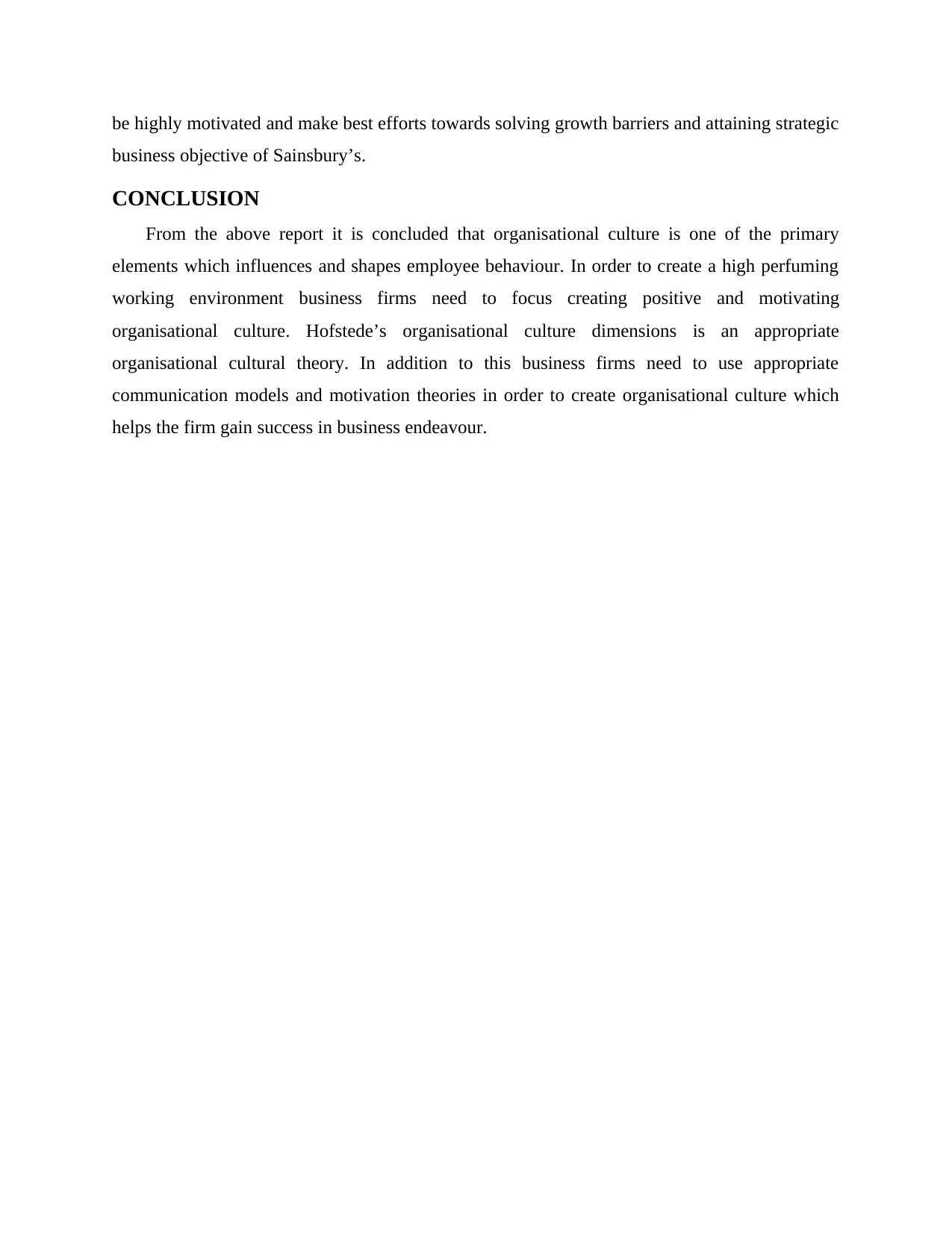
be highly motivated and make best efforts towards solving growth barriers and attaining strategic
business objective of Sainsbury’s.
CONCLUSION
From the above report it is concluded that organisational culture is one of the primary
elements which influences and shapes employee behaviour. In order to create a high perfuming
working environment business firms need to focus creating positive and motivating
organisational culture. Hofstede’s organisational culture dimensions is an appropriate
organisational cultural theory. In addition to this business firms need to use appropriate
communication models and motivation theories in order to create organisational culture which
helps the firm gain success in business endeavour.
business objective of Sainsbury’s.
CONCLUSION
From the above report it is concluded that organisational culture is one of the primary
elements which influences and shapes employee behaviour. In order to create a high perfuming
working environment business firms need to focus creating positive and motivating
organisational culture. Hofstede’s organisational culture dimensions is an appropriate
organisational cultural theory. In addition to this business firms need to use appropriate
communication models and motivation theories in order to create organisational culture which
helps the firm gain success in business endeavour.
⊘ This is a preview!⊘
Do you want full access?
Subscribe today to unlock all pages.

Trusted by 1+ million students worldwide
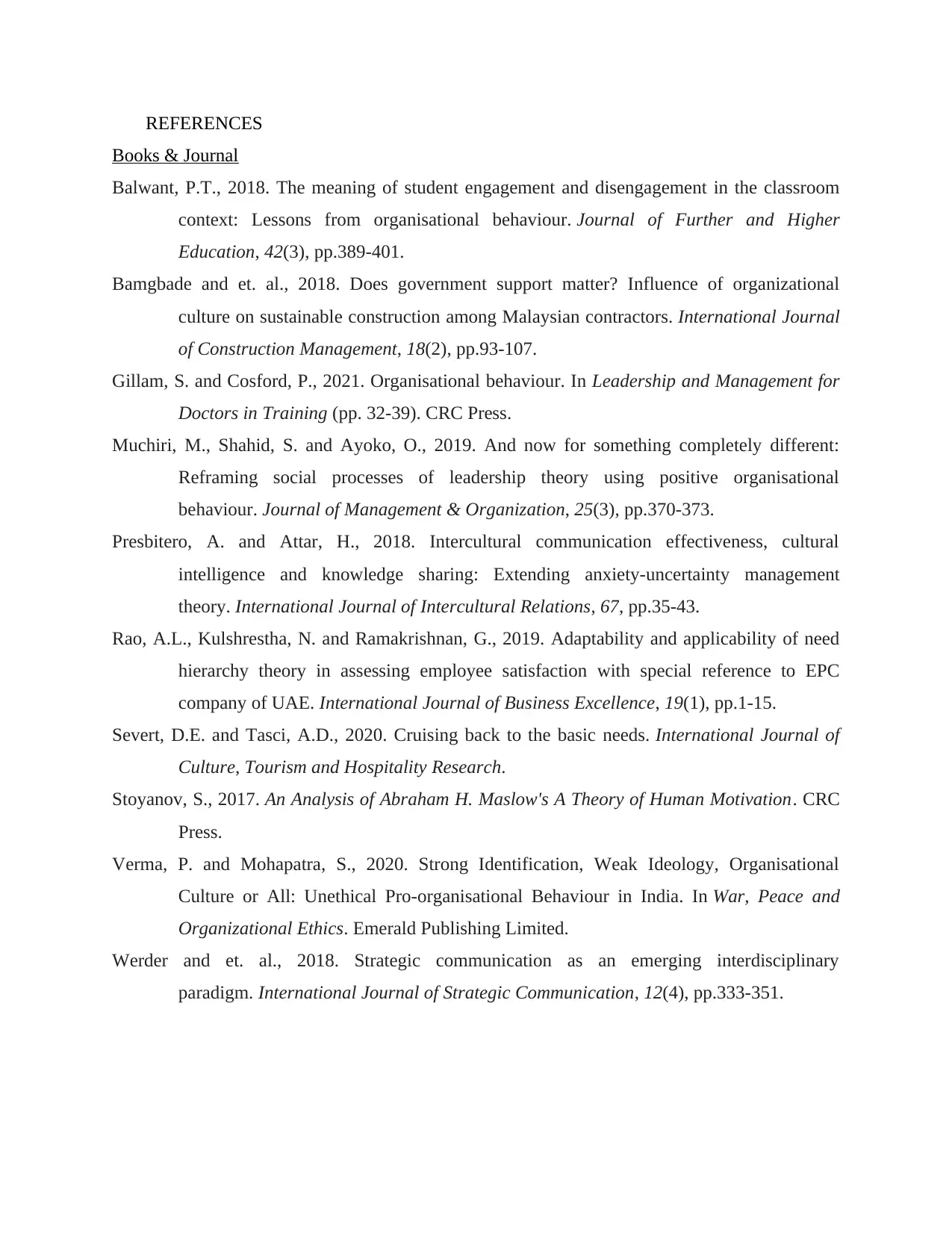
REFERENCES
Books & Journal
Balwant, P.T., 2018. The meaning of student engagement and disengagement in the classroom
context: Lessons from organisational behaviour. Journal of Further and Higher
Education, 42(3), pp.389-401.
Bamgbade and et. al., 2018. Does government support matter? Influence of organizational
culture on sustainable construction among Malaysian contractors. International Journal
of Construction Management, 18(2), pp.93-107.
Gillam, S. and Cosford, P., 2021. Organisational behaviour. In Leadership and Management for
Doctors in Training (pp. 32-39). CRC Press.
Muchiri, M., Shahid, S. and Ayoko, O., 2019. And now for something completely different:
Reframing social processes of leadership theory using positive organisational
behaviour. Journal of Management & Organization, 25(3), pp.370-373.
Presbitero, A. and Attar, H., 2018. Intercultural communication effectiveness, cultural
intelligence and knowledge sharing: Extending anxiety-uncertainty management
theory. International Journal of Intercultural Relations, 67, pp.35-43.
Rao, A.L., Kulshrestha, N. and Ramakrishnan, G., 2019. Adaptability and applicability of need
hierarchy theory in assessing employee satisfaction with special reference to EPC
company of UAE. International Journal of Business Excellence, 19(1), pp.1-15.
Severt, D.E. and Tasci, A.D., 2020. Cruising back to the basic needs. International Journal of
Culture, Tourism and Hospitality Research.
Stoyanov, S., 2017. An Analysis of Abraham H. Maslow's A Theory of Human Motivation. CRC
Press.
Verma, P. and Mohapatra, S., 2020. Strong Identification, Weak Ideology, Organisational
Culture or All: Unethical Pro-organisational Behaviour in India. In War, Peace and
Organizational Ethics. Emerald Publishing Limited.
Werder and et. al., 2018. Strategic communication as an emerging interdisciplinary
paradigm. International Journal of Strategic Communication, 12(4), pp.333-351.
Books & Journal
Balwant, P.T., 2018. The meaning of student engagement and disengagement in the classroom
context: Lessons from organisational behaviour. Journal of Further and Higher
Education, 42(3), pp.389-401.
Bamgbade and et. al., 2018. Does government support matter? Influence of organizational
culture on sustainable construction among Malaysian contractors. International Journal
of Construction Management, 18(2), pp.93-107.
Gillam, S. and Cosford, P., 2021. Organisational behaviour. In Leadership and Management for
Doctors in Training (pp. 32-39). CRC Press.
Muchiri, M., Shahid, S. and Ayoko, O., 2019. And now for something completely different:
Reframing social processes of leadership theory using positive organisational
behaviour. Journal of Management & Organization, 25(3), pp.370-373.
Presbitero, A. and Attar, H., 2018. Intercultural communication effectiveness, cultural
intelligence and knowledge sharing: Extending anxiety-uncertainty management
theory. International Journal of Intercultural Relations, 67, pp.35-43.
Rao, A.L., Kulshrestha, N. and Ramakrishnan, G., 2019. Adaptability and applicability of need
hierarchy theory in assessing employee satisfaction with special reference to EPC
company of UAE. International Journal of Business Excellence, 19(1), pp.1-15.
Severt, D.E. and Tasci, A.D., 2020. Cruising back to the basic needs. International Journal of
Culture, Tourism and Hospitality Research.
Stoyanov, S., 2017. An Analysis of Abraham H. Maslow's A Theory of Human Motivation. CRC
Press.
Verma, P. and Mohapatra, S., 2020. Strong Identification, Weak Ideology, Organisational
Culture or All: Unethical Pro-organisational Behaviour in India. In War, Peace and
Organizational Ethics. Emerald Publishing Limited.
Werder and et. al., 2018. Strategic communication as an emerging interdisciplinary
paradigm. International Journal of Strategic Communication, 12(4), pp.333-351.
1 out of 10
Related Documents
Your All-in-One AI-Powered Toolkit for Academic Success.
+13062052269
info@desklib.com
Available 24*7 on WhatsApp / Email
![[object Object]](/_next/static/media/star-bottom.7253800d.svg)
Unlock your academic potential
Copyright © 2020–2025 A2Z Services. All Rights Reserved. Developed and managed by ZUCOL.




